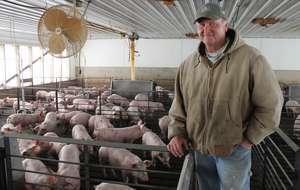PART I: Cleanliness is Key to Good Animal Health
Musings of a Pig Farmer
by Larry Sailer
In my September 11th column, I promised to give you an insider’s looks at modern hog production. Today I’m kicking off a blog series that will follow a group of pigs from about 50 pounds to 290 pounds. I’ll try to show just what these pigs have for shelter and what it takes for me to take care of them.
We took delivery of our most recent group of pigs on Aug. 29. Before they were delivered, however, we had a lot of work to do! We get ready for a group of pigs by power washing the barns until every last speck of organic matter has been removed. We then disinfect the barns with one of several disinfectants; we rotate the disinfectants to prevent immunity from building.
 Clean buildings are key to keeping animals as healthy as possible. Healthy pigs grow better, reach market weight faster and require fewer vaccinations. You can think of this process as “bringing pigs into a new world.” When the first settlers to this country, they brought with them illnesses that were very deadly to the people already living here as they didn’t have any immunity to the new bacteria and viruses. The same is true with animals: We don’t want to expose pigs to anything for which they don’t have immunity. This is why you see signs by livestock barns that read, “STAY OUT.” Hog producers aren’t unfriendly! They’re simply watching out for the pigs’ interests. Limiting access to the barn is a very good way to control the health of those pigs.
Clean buildings are key to keeping animals as healthy as possible. Healthy pigs grow better, reach market weight faster and require fewer vaccinations. You can think of this process as “bringing pigs into a new world.” When the first settlers to this country, they brought with them illnesses that were very deadly to the people already living here as they didn’t have any immunity to the new bacteria and viruses. The same is true with animals: We don’t want to expose pigs to anything for which they don’t have immunity. This is why you see signs by livestock barns that read, “STAY OUT.” Hog producers aren’t unfriendly! They’re simply watching out for the pigs’ interests. Limiting access to the barn is a very good way to control the health of those pigs.
 The pigs arrive at my site by semi, which is driven by a certified driver. Truckers Quality Assurance (TQA) is a program developed by the National Pork Board to ensure that driver takes the best care of the pigs he’s delivering. Likewise, I am Pork Quality Assured (PQA) and take training courses to make sure that I understand how to best care for my animals. There are many different ways to care for pigs, and most any system can do a good job IF there is good management. Likewise, the very best designed system can fail if not properly managed!
The pigs arrive at my site by semi, which is driven by a certified driver. Truckers Quality Assurance (TQA) is a program developed by the National Pork Board to ensure that driver takes the best care of the pigs he’s delivering. Likewise, I am Pork Quality Assured (PQA) and take training courses to make sure that I understand how to best care for my animals. There are many different ways to care for pigs, and most any system can do a good job IF there is good management. Likewise, the very best designed system can fail if not properly managed!
I receive the pigs from a nursery when they weigh about 50 pounds. They are first farrowed, or born on a farm, where the sows are kept. When the pigs are about 20 days old and weigh about 14 pounds, they’re taken to the nursery while they still have some natural immunity from the sow’s milk. As they get older, the sow loses the ability to pass immunity through her milk. By moving pigs to a disinfected nursery, the goal is to keep them as healthy as possible. They stay in the nursery about seven weeks and are about 50 pounds when they are then shipped to my finish barns. I will take care of them for about 120 days and the pigs should gain 240 pounds while I have them.
In future blogs, I will explain about the buildings I use and why. If you have done the math, this group of pigs will be with me for about four months. I’ll try to get into the different aspects of my operation. If there are some questions you have, I will address them as we go along. Please let me know what questions you have. My goal is to help you understand how and why I do the things I do to take the very best care of these pigs.
Related Posts:
- Take a Walk through Time
- Virtually Walk through Our Genetic Garden
- Genetic Garden Shows How Different Types of Corn React to Drought
- Corn as High as an Elephant’s Eye
- History is growing in Alexander
